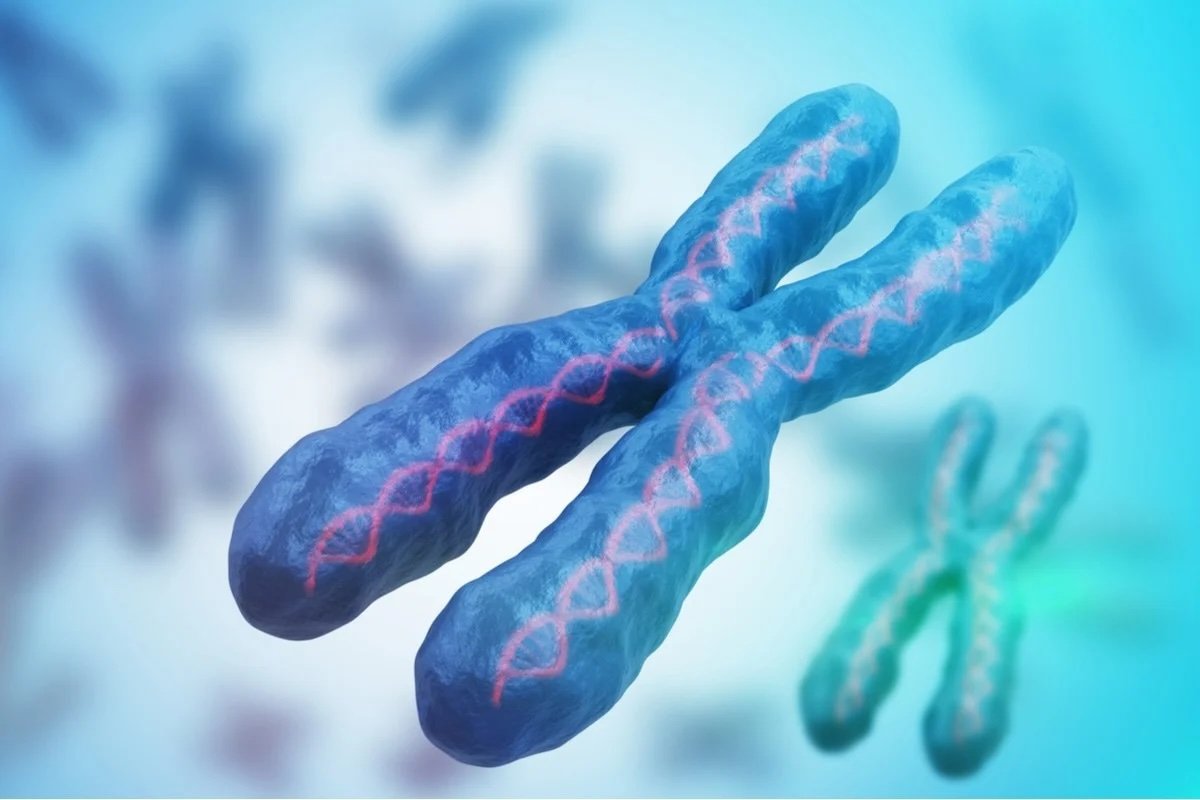Chromosome 2
In the debate about the origin of man it has been suggested that humans developed naturally from apes by gradual change. However apes have 48 chromosomes whereas humans only have 46 (23 pairs). The difference has been explained by the theory that two ape chromosomes have fused to become the human chromosome 2. What is the evidence for this? Chromosome 2 in humans is a long chromosome. Furthermore when these chromosomes are specially stained there is an extraordinary and striking correlation between the pattern of bands seen in the chimp 2A and 2B chromosomes and those of the elongated human chromosome 2.
Figure 1 The structure of a chromosome
There is still further evidence that such a fusion might have occurred. Every chromosome has a ‘telomere’ at each end. These telomeres are composed of particular sequences of DNA nucleotides (see Figure 1) and have the effect of preventing chromosomes from fusing. In the centre of each chromosome is an area called the centromere, also made of a specialised DNA sequence, which holds together the two paired chromatids that together make up the chromosome. It is to the centromeres that the microtubule spindles attach during mitotic cell division and so help to separate the replicated chromosomes.
Figure 2 Comparing human chromosome 2 markings with chimp 2A and 2B chromosomes
It has been noted that the human chromosome 2 has an internal telomere sequence in the position where the two ape chromosomes would have joined. Normally there would not see such sequences in the middle of a chromosome. There are also two centromere sequences in chromosome 2 instead of the usual one; only one of these is functional, the other being inactive. Both the internal telomere and inactive centromere are in the right places if fusion has occurred. There is therefore strong evidence that two chimp chromosomes, 2A and 2B, have fused to form the one human chromosome 2. This evidence has been used to suggest that there has been a progressive development of apes to humans and Darwinists have trumpeted this evidence. However recent evidence has queried whether this fusion could have have occurred by any known natural processes.
Figure 3 The proposed fusion to form chromosome 2
Dr. Fazale Rana has highlighted that there are major scientific problems in accepting the theory that this fusion and the development of humans could have developed by natural processes.i He reminds us that:
1. Telomeres are extremely effective at preventing chromosome fusion. Fusion of complete chromosomes virtually never occur in nature.
2. Whenever chromosome breakage and subsequent fusions have occurred in nature, the offspring are inevitably either non-viable or deformed and infertile.
3. The extraordinary consequence of the radical genetic and chromosomal differences found between an ape and man is a marked increase in intelligence, dexterity, artistic appreciation and spiritual insight. This difference surely suggests that the changes were not natural but supernatural. We cannot explain them on the basis of scientific understanding.
4. In order for any chromosome change to be passed on to future generations there would need to be an identical change in a corresponding male or female of the species. This would need to occur in the same geographical area and at the identical time for subsequent mating to be possible.
Recent research has shown that it is possible to engineer the sixteen chromosomes in a bakers yeast and fuse them into one or two very long chromosomes. Surprisingly these engineered chromosomes are compatible with life although growth is sluggish. When the engineered yeasts are mixed with the original line of yeasts, it is the original line that thrives. In order for scientists to achieve this genetic change they must engineer both the removal of telomeres from the ends of the chromosomes and render all but one of the centromeres of the fused chromosomes inactive. These complex changes must all occur at the same time for the fusion to be compatible with life.
The possibility of a fusion of two ape chromosomes to form one chromosome is itself remote. For humans to have developed naturally from apes this chromosome change would have to be combined with the synchronous appearance of much new meaningful genetic information. Furthermore for identical chromosome and genetic changes to occur in the gametes of a male and female ape at the same time and in the same geographical area is virtually nil.
The alternative suggestion is that there was a mind engineering both the formation of chromosome 2 in humans and the writing of the new genetic information needed to create man. The evidence does suggest that there has to have been a brilliant creator who has orchestrated all these changes synchronously.
BVP
iFazale Rana, ‘Yeast Gene Editing Study raises Questions about the Evolutionary Origin of Human Chromosome 2’ Reasons to Believe,http://www.reasons.org/explore/blogs/the-cells-design/read/the-cells-design/2018/09/12/yeast-gene-editing-study-raises-questions-about-the-evolutionary-origin-of-human-chromosome-2



